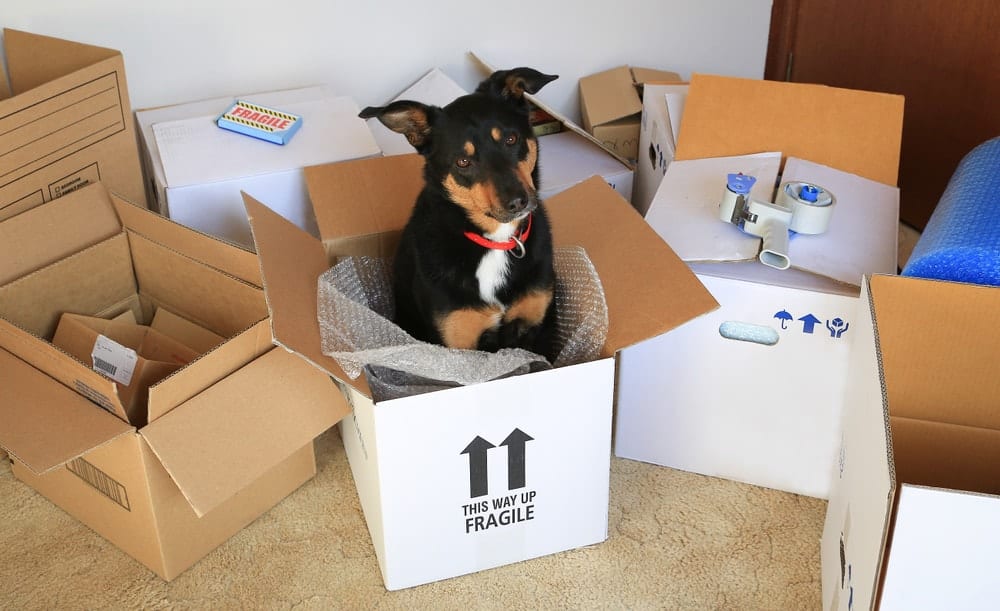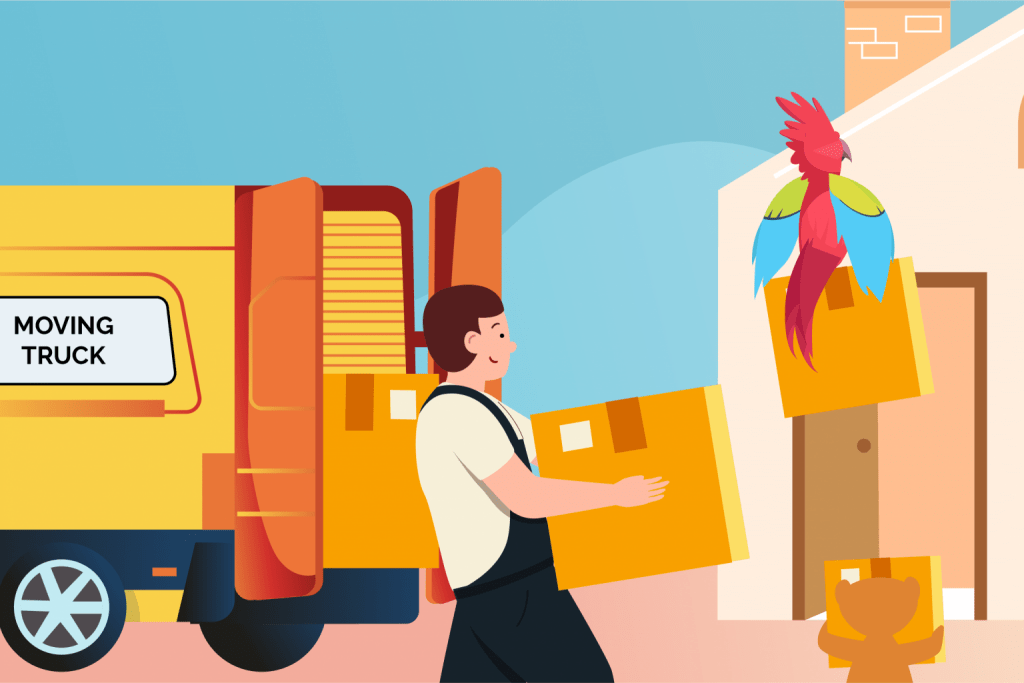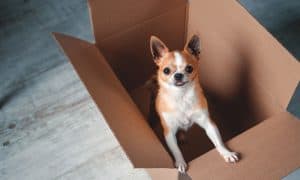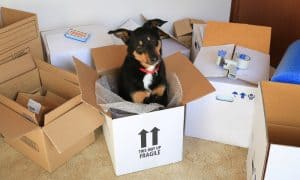“This post contains affiliate links, and I will be compensated if you make a purchase after clicking on my links.”
Moving can be both exciting and complicated. Add your dear dog and other pets to the mix, and things can get a bit more complex.
Whether you are moving to a new neighborhood, new city, or new state, knowing what to do to make both your life and your pet’s life more enjoyable throughout the process can make all the difference.

Here are 21 moving tips that will help you keep your paws all in line and help you and your pet relocate with minimal stress!
1. Drive when possible: Of course, this doesn’t apply for international moves, but for domestic moves driving in a car gives you the relief of knowing you can rush to your pet at a moment’s notice. Flying can be incredibly stressful for our pets as often they must be separated from owners during the flight.
2. Never transport your pet in a moving van: Always keep your pet in the passenger interior of a vehicle. Not only is there proper climate control and protection from shifting furniture but in case of an accident, the interior is designed to provide safety and protect everyone who is a passenger.

3. For flying, carry-on is always best: Can you imagine flying in the cargo hold of a plane? Now imagine your dear doggo stuck down there. Yikes. For carry-on, checking in a pet can be complicated. It’s important to have all your paperwork, specific, approved carriers, and be prepared to manage any accidents that might occur while you are flying. Make sure to do your homework and research the specific policies for the airline.
4. Professional pet movers can help: Exotic breeds and oversized dogs may need special attention when trying to move. This can be particularly useful for overseas moves and ensure your pet doesn’t endure too much stress in the process.
5. Collar tag and microchip updates: Make sure your pet’s microchip and/or collar tag have your new address and the most current contact information. NOTE: Shelters report that almost 60% of cases when they cannot return a microchipped pet to owners are due to incorrect contact information.
6. Refill prescriptions: You probably haven’t found a new vet in the town or area you are moving to, so if your pet has any prescriptions be sure to stock up.
7. Keep vaccination and other medical records handy: This is especially important if traveling overseas. Regardless of where you are moving through, this information will help in case of an emergency as well.
8. Research local laws and regulations: Check local immunization, leashing, registration, and other local requirements for your area.
9. Before your trip, work on crate and carrier acclimation: It is very important to begin the process of crate or carrier training weeks before your move. One trick is to place food inside the crate during feeding to help your pet develop a positive association with being inside.

10. Before your trip, introduce your pet to car rides: All dogs are different, some like car rides and some don’t. For those that have not spent much time in the car, particularly in their crate, start with spending time in the car (not moving) and in the crate, then progressively increase from short rides to long rides to help slowly build confidence.
11. Keep your dog away from the packing process: Dogs are sensitive to what is happening in the home. They will start to notice disappearing items and collections of boxes. Especially important on moving day, keep your pup isolated from the in and out of the move to help them stay calm and protected from the chaos. You can confine them to a single room with the door closed, for example.
12. For drives, plan a dog-friendly road trip: Look for a route where you can take dog-friendly breaks like stopping at a dog park. If you need to stay in a hotel, make sure that you find a dog-friendly place to stay.
13. Pack a doggy-kit: We recommend including water from your old home, all medical & vaccine records, their favorite toys and bedding, a leash and harness, treats and food, and especially cleaning supplies for any unforeseen accidents.
14. Travel on an empty stomach when possible: Your pup will likely be stressed no matter how much you prepare. Avoid feeding in the hours before you leave and make sure to take a “potty” break before departure to avoid any accidents.
15. Leave companions together, but keep solo-pets separated: If you have two dogs that are buds, don’t separate them and cause additional stress. However, if you are traveling with a dog and a cat that aren’t so chummy, make sure to give them sufficient space!
16. Don’t forget temporary travel tags: You never know what may happen in the bustle of moving, and as much as your dog loves you, sometimes the stress can leave them feeling overwhelmed. In case your dog gets lost somewhere on the way, it’s important to clip on temporary tags that specify your moving date, new address, and up-to-date contact information.
17. When you arrive, set up a space for your dog: When settling into a new home, we all like to have familiar things that help us feel more comfortable. So does your dog! First thing when you arrive, set out a space that’s quiet where you can put your dog’s favorite things like his water bowl, food bowl, and favorite toys.

18. Smaller spaces are safer for anxious pups: Sometimes it can take time to adjust to a new home. Leaving your pet to wander an entire new home can leave them overwhelmed. Start small and make sure they are confined to single rooms when you leave the house.
19. Keep a routine: As soon as you can, pick up your regular feeding, exercise, and sleep routines to help with adjusting to the new norm.
20. Give it time: Every dog will adjust at his or her own pace. Don’t let yourself get anxious, that will only make your pup more anxious! Be loving and patient, that’s all your pet needs.
21. Stay calm: Perhaps easier said than done, since you’ve just moved, but remember this is a new home and an exciting time for your family. Don’t feel rushed to get everything in place. Instead spend time nurturing your pet and your family to make the process more enjoyable and to reduce anxiety for everyone.



















Gambu
Mar 31, 2021 at 6:58 am
in 17 you say his. my dog is a her
Afton Jackson
Mar 29, 2021 at 3:08 am
Your tips on how to practice things like crate and carrier behaviors with your dog were very helpful to read. Moving is tiresome enough, but I can see it being even harder with a puppy as playful as mine making things hectic. I’ll make sure I practice how to carry him around in a behaved manner before getting a full service moving company to help us relocate so he doesn’t cause any trouble.